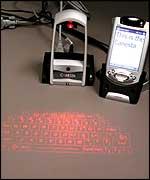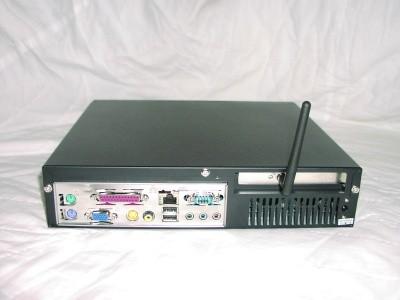30 January 2003
StockholmOpen.net
I am attending a project proposal meeting in Stockhom, with partners from around Europe (Sweden, Germany, Spain and so on). The university here (KTH) provide a WLAN wireless network (802.11b) here on their campus, and elsewhere in Kista (a suburb of Stockholm) and the city centre itself, with Internet connectivity. So I am connected to the Internet via my laptop with WLAN wireless connectivity while sitting in the meeting on campus.
Now, many companies and universities have private WLAN networks, and some allow visiting guests access to these. What is very exciting about the deployment here is that the wireless network is shared between a number of different operators using the StockholmOpen.net software and infrastructure. Currently the university itself (who sponsor the experiment), Yanzi Networks, Lidnet, and Telia all share the same access network and provide Internet access via this network. The system allows users to select the operator of their choice (e.g. students use the university and their standard user accounts, shoppers in a shopping centre may buy a card at a counter giving a code which allows access via one of the other operators but both use the same network). The technical details of how this is achieved are available at StockholmOpen.net, and the software is open source and freely downloadable.
To users, once they are connected and using the system, the fact that they are using a multi-operator network makes little difference. It appears to you that the network is owned by your operator. However, it makes a big difference to the cost of deploying such a network, as it can be shared by all operators some of which may be commercial, and others community funded schemes. Potentially the cost could be so low that the network could grow organically as people deploy extra parts and join in to the network.
I will keep this weblog updated with progress on the project proposal we are building around this concept.
25 January 2003
Become a wireless ISP: for 」300
I came across (thanks to Andrew Betson) an excellent description of a commercial UK local access point which can integrate with others via Wi-Fi to share broadband upstream access in a local area Become a wireless ISP: for 」300. It refers back to the author Guy Kewney's own weblog article on the same topic. The basic tenet is that many have argued that mesh computing (sharing wireless connectivity with multiple uplinks) is a complex task, but this UK company LocustWorld (with products like MeshAP and MeshBox) may have proved them wrong. they even have s/w for normal Wi-Fi access points (like US Robitics ones) to allow them to take part in the mesh.
Is metadata is useful or useless?
I've just spent a few hours reading around about the use and misuse of metadata. I started with a an interesting article on XFML (a lightweight distributed categorisation DTD) XML.com: Introduction to XFML [Jan. 22, 2003] (via a mailing list digest I'm on, I know, I should switch to consuming it as an RSS feed but I haven't got there with everything yet). Anways, this led to a criticism of metadata (Metacrap) which reconfirmed my belief that automated reaping of implicit knowledge always beats manual metadata editing (excepting small subdomains where one has a budget to mark up things properly, such as library catalogues, MARC records, the OCLC and all that jazz). Undaunted I browsed on via multifarious links and ended up in the land of TopicMaps/XTM, the W3C Web Ontologies Working Group . Finally, I ended up reading about Dan Connolly's Semanitic Web Travel Tools. It is good to know that we live in a world where people are still working to create open flexible mechanisms to share and exchange structured information in useful ways. It is also interesting that people are using Perl and Python to create filters to exchange between mobile devices and fixed ones in meaningful ways. This mini-browse has reinvigorated me to keep abreast of the lastest in metadata and the semantic web.
24 January 2003
23 January 2003
Phillip J. Windley: Digital Identity, Digital ID
This article Digital ID and eGovernment :: Digital Identity World :: Digital Identity, Digital ID by Phillip J. Windley discusses the issue of digital identify (in a US context). "Governments are vitally concerned with identity and yet, paradoxically, most governments have been largely unwilling to take a leadership role in the digital identity arena."
22 January 2003
Instant Insecurity: Security Issues of Instant Messaging
This article from SecurityFocus.com deals with the security issues relating to IM: Instant Insecurity: Security Issues of Instant Messaging.
21 January 2003
Projection Keyboards

This is an overview article on the current state of Projection Keyboards. It describes four products, gives links to their websites, and describes the companies and lists patents. All very interesting.
20 January 2003
Posting
The recent Netcraft Web Server Survey (Jan 2003) listed a Windows 2000 server as one of the machines (it knew about) on the Internet with the top 50 longest uptimes (the machine was running without a reboot since November 2000).
Microsoft's next frontier: wireless
This is a good CNN article discussing CNN.com - Microsoft's next frontier: wireless - Jan. 19, 2003, in particular the battle for control of the next generation of operating systems for hand held devices and smart phones.Vovida.org -- Your Source for Open Source Communication
This looks like a very interesting location for open source telecommunications software: Vovida.org -- Your Source for Open Source Communication. Note that Tim Chown (University of Southampton and UKERNA) has edited a report which includes deployment of an IPv6 version of VOCAL (Report on IPv6 Experiments, Published 2002-09-11) which is a VoIP solution from Vovida.org. This report also mentions other activities related to IPv6 at the applications layers: Globus Toolkit v2 (computational grids). Finally it cross references activity taking place under 6NET, an EU-funded FP5 Project.18 January 2003
Posting
I have recently discovered that the Irish ODTR (Telecommunications Regulator) has an online map of all registered mobile masts. Here are the masts in my area (Waterford-Dungarvan): Mobile Masts Map. Very interesting.StockholmOpen
In London this weekend (UCL) I met with a number of people from the StockholmOpen.net group. This is driven by KTH (The Technical University in Stockholm). The idea is to have a Wi-Fi network shared by multiple operators and to enable end users to choose which operator they wish to use. In Stockholm some WISP (Wireless ISPs) and the uiniversity share the access network so students and anyone else can get wireless access to the Internet in the parts of the city where they have coverage. They compare themselves technically to NoCat and NetLogOn, and their software is open source and avialable for download on their website.
16 January 2003
FOAF - an RDF syntax
One of the things Bernie encouraged me to do was to fill in a "Friend of a friend" XML metadata descrition of myself. Researching this shows me sites to help create one: FOAF-a-matic -- Describe yourself in RDF, and sites describling the background:- The Friend-of-a-Friend vocabulary can make it easier to manage online communities
- FOAF: the 'friend of a friend' vocabulary
Bernie Goldbach
I met with Underway in Ireland author Bernie Goldbach today and we had a chat about GeoURL, Wi-Fi, and other Bloggy things. It was interesting to see how quickly the use of GeoURL spread through the Blogging community. I have now added a CSS GeoURL link in the sidebar to this site. Use it to see who may neighbours are in GeoURL space.9 January 2003
RSS 2.0 for Moveable Type
RSS 2.0 template [dive into mark] I have installed Mark Pilgrim's RSS 2.0 template for Moveable Type. Had some trouble with invalid characters in the RSS file generated. I simply changed the encoding from utf-8 to iso-8859-1, to allow for the accents in my name, and this was fixed (which appear in a title field). So this is the new feed.8 January 2003
Latin English Dictionary on-line
Latin-English Dictionary On-line Latin-English dictionary.6 January 2003
Geourl
Yesterday I added this Blog index to the GeoURL ICBM Address Server. This means that the website advertises (via some meta tags in the header) its location in terms of a grid reference. You can then use the system to query where other sites are in relation to this. Sites which move (unlike this one) can regulary let the main site know when their location has been updated.5 January 2003
The Disruptive Web, Jon Udell
The disruptive Web An article about the creation and dissemination of a useful webservice based on books, and their ISBNs.Leslie Lamport's Home Page
Leslie Lamport's Home Page The author of LaTeX here lists all his publications, with annotations/comments on each and links to electronic versions as appropriate. He has been very active in formal mathematical approaches to distributed computing over a number of decades. Ironically, he is now working for Microsoft, which he had earlier referred to as "Going over to the dark side" c.f. How (La)TeX changed the face of Mathematics Mitteilungen der Deutschen Mathematiker-Vereinigung 1/2000 (Jan 2000) 49-51.3 January 2003
Posting
ElectricNews.net:News:Ireland and China sign research pact SFI has new fund for Chinese collaboration.2 January 2003
MSNBC Article: AOL Patents Instant Messaging
AOL patents instant messaging AOL has filed a patent based in ICQ's IM but the definition is so broad that it is a threat to any IM product (inluding MS and Yahoo). This will be interesting. Umm, wonder if it covers "finger/talk" in Unix where the "network" is one of terminals?Web-safe colours
HTML Color Codes - a VisiBone Wheel; see also the Colour Lab.Larry Seltzer
Operating Systems and Platform Migration / XML on a chip? - ZDNet Tech Update discusses the use of hardware acceleration to allow XML processing and web services for heavy usage. Puts this in the context for hardware acceleration for lower network stack layers (e.g. routers).1 January 2003
Jon Udell's weblog
A recent entry in Jon Udell's weblog referenced a whole series of interesting things: New York Times Article on who owns the internet (quoting Joseph Turow's suggestion that a small "i" was more suitable than a capital one so as to allow for global ownership); that William Gibson's statement that "the future is here, just not evenly distributed" (as cited in Tim O'Reilly's 2002 column on emerging technologies); and concept of active paper (as refernced here in an earlier weblog entry); and reference to an interesting book on W-Fi.
